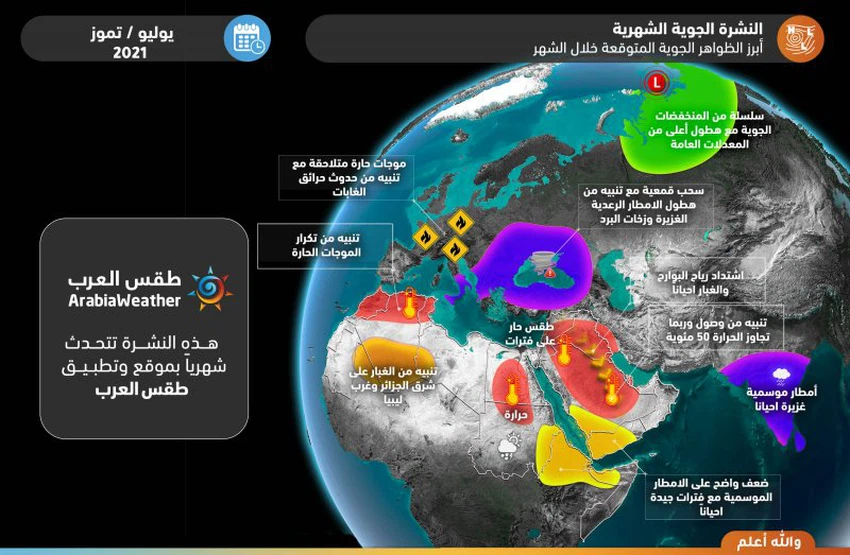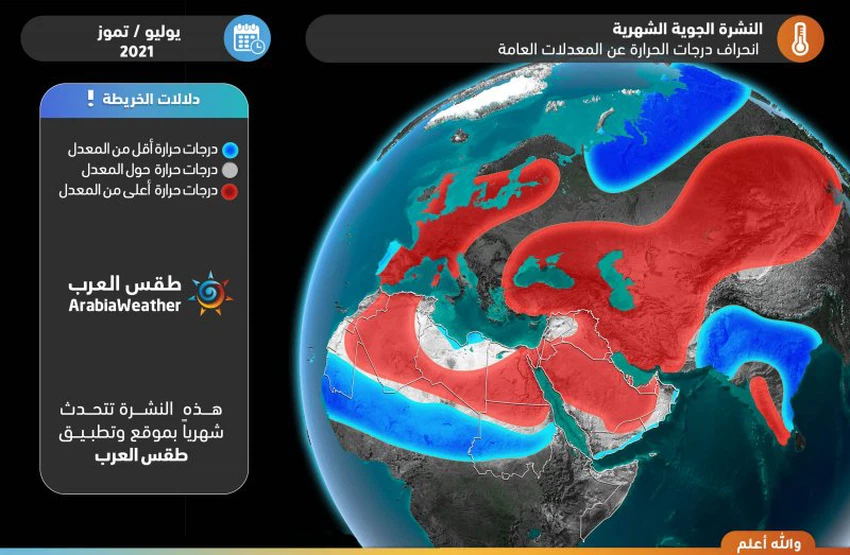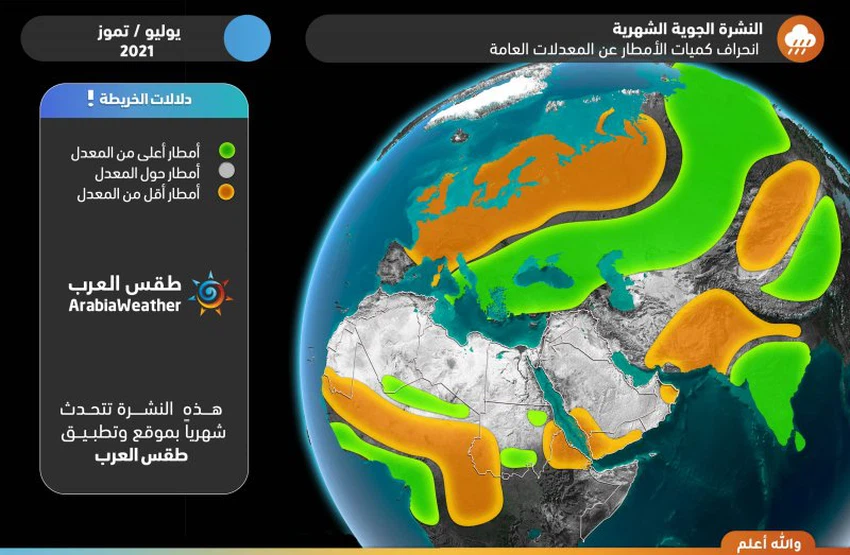Arabia Weather releases its forecast for July | Record hot and sometimes dusty and drought hits the southwestern region!
Monthly weather forecast for the Kingdom of Saudi Arabia
A record-hot month and sometimes dusty, and drought hits the southwestern region of the region
Note: It is strictly forbidden to transfer this information, data, and the weather forecast, to publish it on social media and others, and/or to dispose of it in any way without the prior and written consent of Arab Weather, under penalty of legal accountability.
Weather of Arabia - Arab Weather provides you with the expected monthly weather forecast for the month of July 2021 .
June 2021 release .
The issuance of these forecasts depends on studying the behavior of temperature and atmospheric pressure in the northern hemisphere, including the atmosphere and major water bodies, and integrating those forecasts with global monitoring centers, to come up with the highest possible forecast.
Arab weather experts in the Scientific Research and Development Department have developed scientific methods that are considered the first of their kind in the Arab world and the world, relying on artificial intelligence in forecasts for the coming months, by developing complex mathematical algorithms and equations to detect atmospheric behavior and correct long-range weather forecasts.
Unlike the daily weather bulletin, these bulletins focus on listing the general weather during a month, where the aim is to know the deviation of rainfall and temperatures from their general rates. Many meteorologists in the world are busy trying to decipher the mystery of making accurate seasonal forecasts by conducting many researches in this regard, in which the Arab Weather team participates in part.
The desired benefit of the quarterly bulletins lies in assisting the various sectors in the early planning for the fall and winter alike, especially the agricultural sector, which builds its agricultural plans on these indicators that sometimes help to reap and achieve profits by exploiting this information, in addition to many other sectors that Benefit from these forecasts, such as the commercial sectors, the apparel sector, the energy sector and others.
General situation
-
Improvement in the chances of rain in southwest Saudi Arabia may include Taif, Makkah and the heights west of Madinah in the first third of the month.
-
Very hot weather on some days during the first half of the month, and the temperature may exceed 50 degrees Celsius in parts of eastern Saudi Arabia.
-
The intensification of the dusty winds of Al-Bawareh in the second half of the month in the north, central and western parts of the Kingdom may include Riyadh, with the possibility of developing into dense dust waves in the east.
-
It is expected that the weather will tend to moderate with the early morning hours during the last third of the month in parts of northwest Saudi Arabia.
-
Slightly refractory (decreasing the number of very hot days) with the temperature remaining above the general rates in various regions during the second half of the month.
-
A period of drought / lack and weakness of seasonal rains is expected in the southwestern region during the second half of the month.
Weather forecast for this month هذا
general air systems

temperature forecast

rain forecast

The most important weather phenomena expected this month

Special weather condition for each month
First week (July 1-7, 2021)
|
Region |
rain forecast |
temperature forecast |
Recommendations |
|
middle of Saudi Arabia |
There is no / no significant rain |
above average |
Severe heat alert |
|
northern Saudi Arabia |
There is no / no significant rain |
above average |
Severe heat alert |
|
southern Saudi Arabia |
thunder showers |
about average |
Warning of the formation of torrents |
|
Eastern Saudi |
There is no / no significant rain |
above average |
|
|
western Saudi Arabia |
Chance of scattered rain in the mountains |
above average |
Severe heat alert |
General forecast for the month
- The Scandinavian atmospheric height intensifies in conjunction with the low pressure over the Arctic Dome and the control of the subtropical high air over northern Africa, and this leads to pushing the cold air basins towards the middle of the Mediterranean Sea and the intensification of the subtropical high air and deepening on the pressure values in the thermal depressions on the Arabian Peninsula and low Seasonal India on the Persian Gulf includes Eastern.
- This results in strong heat waves (extremely hot weather) where temperatures around the mid-forties, and perhaps more, prevail over many regions of the Arabian Peninsula, with warnings that the temperature may exceed the fifty-degree mark in parts of eastern Saudi Arabia.
- It is also expected that the intensification of the subtropical air altitude will lead to an improvement in the extent and intensity of seasonal rains on the south and west of the Arabian Peninsula, including the highlands of southern and western Saudi Arabia.
- It is expected that during this week, the chances of seasonal dust will rise in parts of southern Saudi Arabia, especially at the end of the period, as it is caused by an increase in the atmospheric pressure difference between the seasonal Sudan depression and the atmospheric high in Ethiopia, which leads to raising dust and dust in Sudan and transferring it to parts of the highlands. southern Saudi Arabia.
Second week (8-14 July 2021)
|
Region |
rain forecast |
temperature forecast |
Recommendations |
|
middle of Saudi Arabia |
There is no / no significant rain |
above average |
Severe heat alert |
|
northern Saudi Arabia |
There is no / no significant rain |
above average |
|
|
southern Saudi Arabia |
scattered showers |
about average |
|
|
Eastern Saudi |
There is no / no significant rain |
above average |
|
|
western Saudi Arabia |
There is no / no significant rain |
above average |
Warning of extreme heat at the beginning of the period |
General forecast for the month
- Atmospheric pressure values rise over large areas of the north, west and south of the European continent, in addition to parts of the Arctic, which leads to a gradual shift of the temperate air masses towards the central and eastern Mediterranean.
- This leads to a gradual weakening of the strength of the subtropical air altitude over the Arabian Peninsula and the Levant.
- This results in a gradual reversal of the heat in the north and west of the Arabian Peninsula, with the temperature remaining above its general rates in large areas, especially eastern Saudi Arabia.
- As the rain begins to shrink, and its intensity weakens.
- During this week, it is expected that the chances of seasonal dust will increase in parts of southern Saudi Arabia, as it is caused by the increase in the atmospheric pressure difference between the seasonal depression of Sudan and the high altitude in Ethiopia, which leads to raising dust and dust in Sudan and transferring it to parts of the highlands of southern Saudi Arabia, in addition To the activity of the movement of the northern surface winds on the coasts of Jizan, which leads to the raising of dust and dust locally on those coasts.
Third week (July 15-21, 2021)
|
Region |
rain forecast |
temperature forecast |
Recommendations |
|
middle of Saudi Arabia |
There is no / no significant rain |
above average |
Dusty |
|
northern Saudi Arabia |
There is no / no significant rain |
above average |
Dusty |
|
southern Saudi Arabia |
scattered showers |
about average |
dry period |
|
Eastern Saudi |
There is no / no significant rain |
above average |
Dusty |
|
western Saudi Arabia |
There is no / no significant rain |
above average |
|
General forecast for the month
- It is expected that during this month, atmospheric pressure values will decrease with a weakening of the strength of the Scandinavian atmospheric height with a rise in atmospheric pressure on the central and western European continent and parts of the Arctic, coinciding with a gradual and continuous weakening of the strength of the subtropical atmospheric height on the Arabian Peninsula.
- This increases the chances of moderate-temperature northwesterly currents extending towards northern Egypt, the Levant, and northwest Saudi Arabia, noting that the temperature remains higher than its general rates in all regions, but less sharply than the first half of the month.
- The southwestern region of the Arabian Peninsula enters a period of atmospheric stability and dryness/lack of seasonal rains due to the weakness of the eastern regions, which carry with them the moisture necessary to build clouds after God's will.
- It is also expected that the Al-Bawareh winds will be active at intervals, as it is expected to lead to the activity of dusty surface winds in parts of eastern, central and eastern Arabia, which may include Riyadh, Dammam and Kuwait.
Fourth week and rest of the month (July 22-31, 2021)
|
Region |
rain forecast |
temperature forecast |
Recommendations |
|
middle of Saudi Arabia |
There is no / no significant rain |
above average |
Heavy dust alert sometimes |
|
northern Saudi Arabia |
There is no / no significant rain |
above average |
Heavy dust alert sometimes |
|
southern Saudi Arabia |
scattered showers |
Below average |
dry period |
|
Eastern Saudi |
There is no / no significant rain |
above average |
Heavy dust alert sometimes |
|
western Saudi Arabia |
There is no / no significant rain |
above average |
|
General forecast for the month
- During this period, atmospheric pressures are expected to rise significantly over the North Pole and large areas of the European continent, which will increase the volume of moderate air reaching the Mediterranean basin, which will affect northern Egypt, the Levant, and northern and western Arabia.
- This results in an additional decline in the intensity of the hot weather in large areas of northern and western Saudi Arabia, and to a lesser extent in the rest of the regions, but with the temperature remaining above the general rates.
- The drought continues in southwestern Saudi Arabia.
- Al-Bawarih winds are expected to intensify, especially in the last week of the month, which may lead to the formation of dense dust waves, sometimes in parts of eastern Saudi Arabia, in addition to Qassim and Riyadh.
Climatic situation (for specialists and those interested)
The Arctic Circle and the Atlantic Ocean
The atmospheric pressure in the Arctic Circle is expected to decrease for most of the month, which is known as the positive Arctic Oscillation Coefficient ( AO ), coinciding with overall neutral values in the North Atlantic Ocean Index ( NAO ), which explains the shrinkage of air in the higher latitudes and not pushing it strongly towards the south. That is, the Mediterranean basin in the same quality and quantity during the past month.
It would limit the temperate weather in most regions, with the exception of northern Libya and northwestern Egypt, where many regions are waiting for temperatures higher than their usual rates in varying degrees, which may be record and blazing in the Arabian Peninsula.
As for the last days of the month, it is expected that both coefficients will tend to decrease ( AO & NAO ), which means a rise in atmospheric pressure in the Arctic and parts of western Europe in conjunction with the re-intensification of the Scandinavian high air, which means a break in the jet air currents and allowing moderate and lower air Heat to penetrate again from the semi-tropical minimum shows,
This results in the rush of moderately warm air masses towards the central and eastern Mediterranean, which means an additional drop in temperatures and the return of pleasant nights over the mountainous heights.
The Pacific Ocean
The ENSO - Neutral phenomenon continues to dominate the world during this period, with expectations of its continuation during this summer, with a probability of up to 78%, and this phenomenon affects the weather in many regions around the world, as it indirectly contributes to the weakness of seasonal rains in southern and western Arabia, at the expense of improving rains in the Horn of Africa and Sudan, and working on a fair and non-extreme (balanced) distribution in the subtropical air heights, meaning the change of weather systems from time to time.
Indian Ocean
It is expected with a high percentage that the Indian dipole index ( IOD ) will remain in the negative pattern, which explains the significant weakness in the monsoon rains for the Sultanate of Oman and the southwest of the Arabian Peninsula, amid expectations that the negative pattern will continue in the coming months. This means that the surface water temperature in The Arabian Sea and the northern Indian Ocean are below the general averages by more than 0.4 degrees.
In the event that this indicator remains in a negative pattern, this will affect the amount of water vapor arriving inside the Arabian Peninsula, the Red Sea and the Levant, which limits the strength of rain in the first half of the autumn season relative to what is usual for each region.
God knows
Arabia Weather App
Download the app to receive weather notifications and more..



